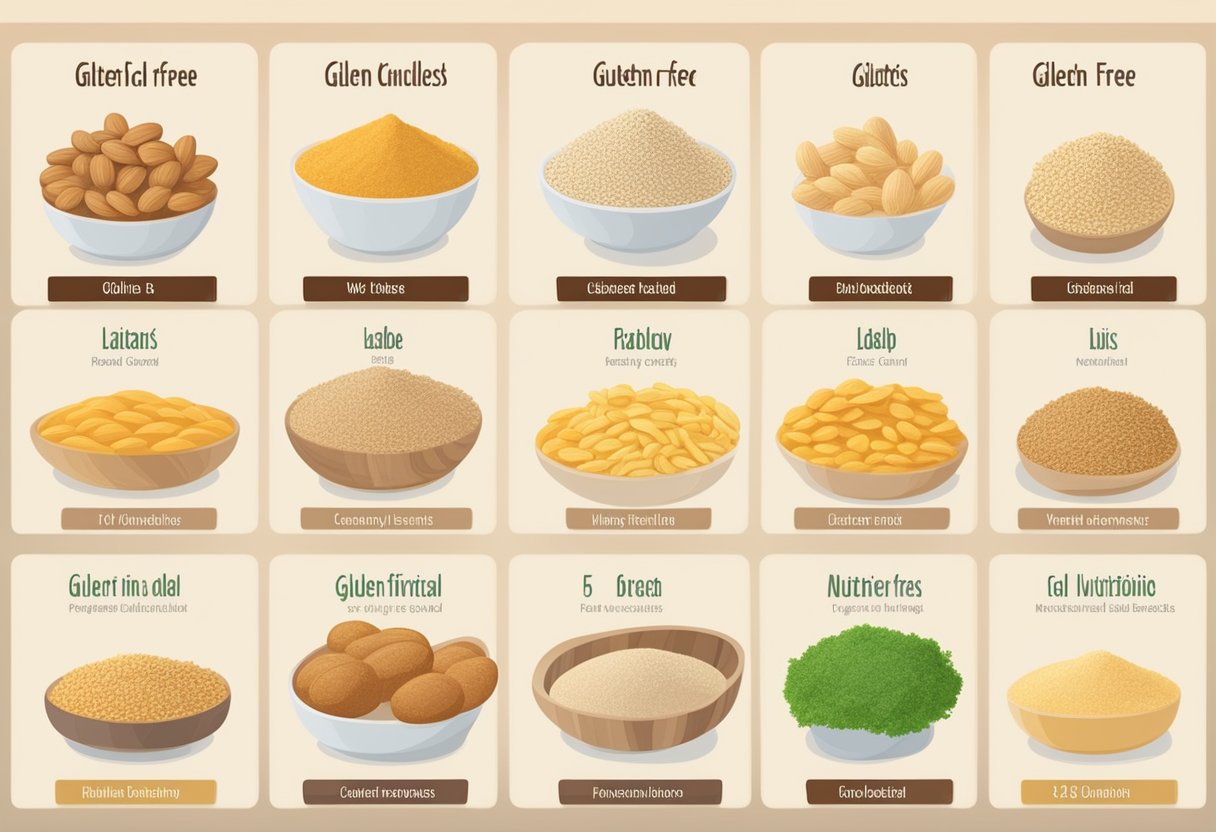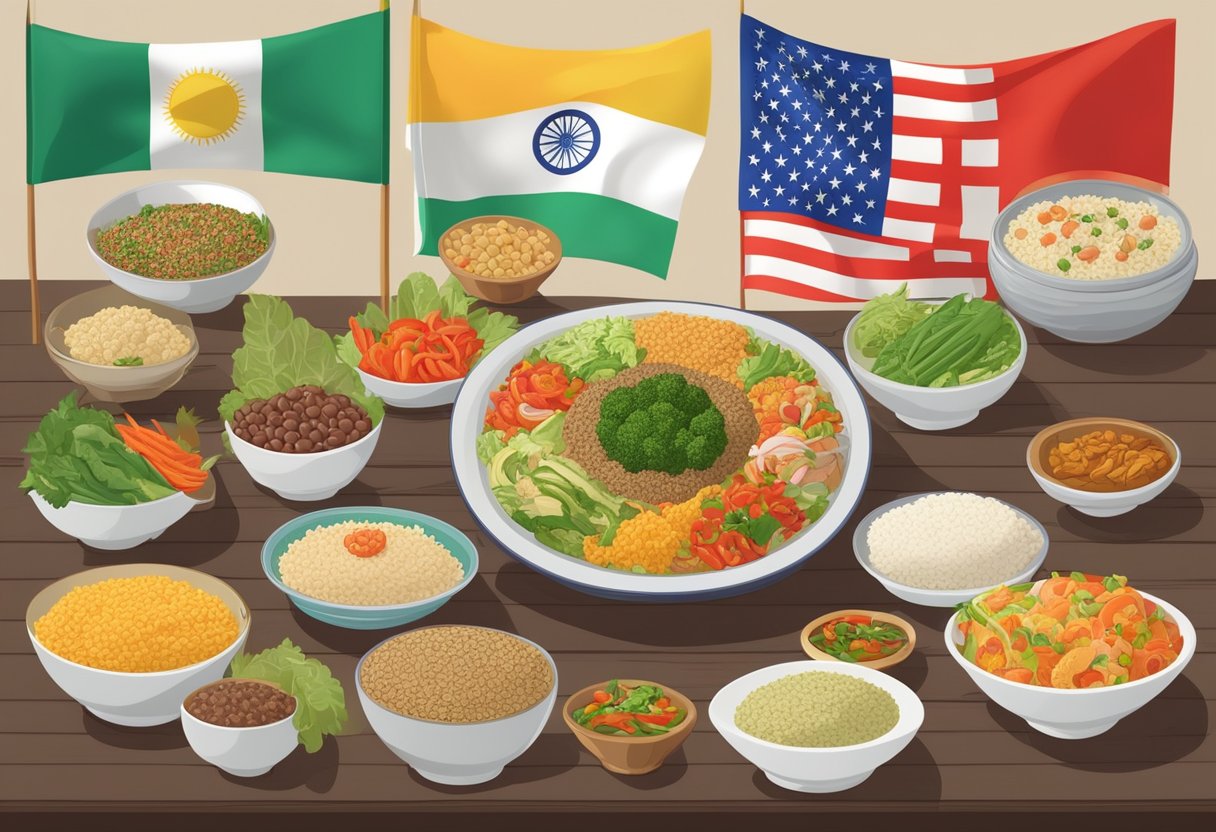The shift towards gluten-free diets has been noteworthy in both medical and health-conscious communities worldwide. Initially essential for those with medical conditions such as celiac disease, the adoption of a gluten-free diet has expanded beyond these groups due to its perceived health benefits. As awareness grows and consumer preferences change, a significant increase in gluten-free products and diets can be observed globally. Consumers are increasingly opting for gluten-free options, not just out of necessity, but also as a lifestyle choice, impacting food industries and dietary cultures around the world.

The rise in gluten-free diets has also led to a surge in scientific research and regulatory efforts to ensure the safety and nutritional adequacy of these diets. Nutritional experts emphasize the importance of understanding the components of a gluten-free diet and their potential health and lifestyle implications. For example, while a gluten-free Mediterranean diet, rich in fruits, vegetables, nuts, and oils, may provide health benefits, it also prompts questions about the nutritional content and the potential need for fortification of gluten-free products. Manufacturers are tasked with maintaining quality control while exploring new gluten-free ingredients and recipes that meet both the nutritional requirements and taste preferences of this evolving market.
Key Takeaways
- Gluten-free diets cater to those with gluten-related disorders and are gaining broader acceptance as a lifestyle choice.
- The nutritional content of gluten-free products and maintenance of quality are critical aspects of gluten-free manufacturing.
- The globalization of gluten-free diets poses unique challenges and opportunities for scientific research and food regulation.
Table of Contents
Understanding Gluten and Its Health Impacts
Gluten is a protein found in wheat, barley, and rye. Its consumption is known to cause health issues for individuals with celiac disease or non-celiac gluten sensitivity, influencing the dietary choices and nutritional intake of affected populations.
Celiac Disease and Non-Celiac Gluten Sensitivity
Celiac disease, also known as coeliac disease, is an autoimmune disorder that is triggered by the ingestion of gluten. It can lead to serious gastrointestinal problems, malabsorption, and a range of other symptoms. Non-celiac gluten sensitivity is a less well-defined condition causing similar but less severe reactions to gluten, without the autoimmune component.
Gluten-Related Disorders beyond Celiac Disease
Disorders such as wheat allergy, dermatitis herpetiformis, and gluten ataxia are also part of the spectrum of gluten-related disorders. While each condition has distinct characteristics, they all require dietary modifications to manage symptoms effectively.
Nutritional Considerations for a Gluten-Free Diet
A gluten-free diet is essential for managing the symptoms and health risks associated with gluten-related disorders. It is crucial to ensure nutritional sufficiency when on a gluten-free diet, which should include a variety of foods, such as those found in a Mediterranean diet, rich in fruits, vegetables, lean proteins, and gluten-free grains to maintain a balanced nutritional intake.
The Gluten-Free Diet: Essentials and Challenges

Navigating a gluten-free diet involves understanding its fundamental requirements and addressing common difficulties. For those requiring this diet, the stakes are high, as proper management is crucial to health and well-being.
Fundamentals of the Gluten-Free Diet
A gluten-free diet excludes all forms of gluten, a protein found in wheat, barley, rye, and potentially oats. This diet is essential for individuals diagnosed with celiac disease, as they must avoid gluten to prevent harmful immune responses. Beyond celiac, some people choose a gluten-free lifestyle for other health reasons, such as non-celiac gluten sensitivity or wheat allergy.
In the context of a gluten-free Mediterranean diet, the emphasis is placed on naturally gluten-free foods such as fruits, vegetables, legumes, nuts, seeds, fish, and fresh meats. Refined gluten-free products are used sparingly, with a preference for whole foods that are naturally devoid of gluten. Grains that typically feature in this dietary pattern include gluten-free varieties like quinoa, buckwheat, and rice.
Common Challenges and Management
Adhering to a gluten-free diet can pose several challenges, such as:
- Identifying hidden sources of gluten in food products
- Lack of options when eating out or traveling
- Higher cost of gluten-free products
- Managing cross-contamination risks
Interventions for addressing these challenges include thorough education on gluten-free living and practical management strategies. Individuals should read labels carefully to detect gluten-containing ingredients, plan ahead when dining outside the home, and seek out specialist retailers and restaurants. There’s an ongoing need for accessible and affordable gluten-free options to improve diet adherence.
Furthermore, support from healthcare providers, dietitians, and support groups can be pivotal in helping individuals navigate these challenges, ensuring a balanced diet and maintaining their health.
Health and Lifestyle Implications
Adopting a gluten-free diet is not just about managing celiac disease or gluten intolerance; it has wider health and lifestyle implications. These include its impact on various conditions, the potential for improving quality of life, and how it may interface with physical activity.
Impact on Conditions like IBS and Depression
Individuals with irritable bowel syndrome (IBS) may find symptom relief through a gluten-free diet. Scientific studies, such as Mapping the knowledge structure of a gluten-free diet: a global perspective, have highlighted that a reduction in gastrointestinal symptoms associated with IBS can occur with the elimination of gluten. In addition, there can be an improvement in mood for some individuals, possibly reducing factors like depression and anxiety, which are commonly reported alongside IBS.
Quality of Life and Psychological Effects
The quality of life can be significantly improved for those on a gluten-free diet, especially for individuals with a gluten-related disorder. However, it requires a considerable lifestyle adaptation, with potential stressors included in maintaining strict dietary control. Living gluten-free: adherence, knowledge, lifestyle adaptations and their impact on quality of life outlines how knowledge and adherence to a gluten-free diet can influence psychological effects. It’s paramount for one’s mental health to manage the feelings of restriction and stress that may accompany this diet.
Gluten-Free Diet and Physical Activity
Physical activity is an essential aspect of maintaining overall health, and the effects of a gluten-free diet on this domain are noteworthy. Adequate nutrient intake, particularly iron, is crucial to prevent malabsorption and its consequent impact on energy levels and inflammation. Those on a gluten-free diet must carefully ensure their meals are nutritionally balanced to support an active lifestyle. By opting for a gluten-free Mediterranean diet, individuals can combine the benefits of reduced inflammation and a diversified intake of essential nutrients, which might enhance physical activity endurance and performance.
Nutritional Content of Gluten-Free Products

When evaluating gluten-free products, it’s important to consider their nutritional content, including how they compare to their gluten-containing counterparts in terms of essential nutrients like vitamins, minerals, and fiber.
Analyzing Gluten-Free Cereals and Flours
Gluten-Free Cereals: These often include grains such as rice and corn. When it comes to rice, it’s a staple in a gluten-free Mediterranean diet, lauded for its versatility and relatively low glycemic index compared to some other gluten-free options. However, rice lacks certain key nutrients found in whole gluten-containing cereals.
Corn, another common ingredient, serves as a focus in many gluten-free diets, chosen for its gastrointestinal tolerance. However, corn-based cereals must often be fortified to match the nutritional profile of their wheat-based counterparts, due to lower levels of minerals like calcium and zinc.
Gluten-Free Flours: Made from a variety of ingredients, gluten-free flours are essential in replicating the textures and tastes of traditional wheat flours. They can be made from a range of materials – from nut-based to legume-based types – each with distinct nutritional profiles. Despite their diversity, many gluten-free flours lack adequate fiber, making it important to source fiber from other foods in a gluten-free Mediterranean diet.
Nutritional Adequacy and Deficiencies
The nutrients in gluten-free products can vary widely, making nutritional adequacy a key concern for those adhering to a gluten-free diet. Often, gluten-free products are insufficient sources of important nutrients like iron and B vitamins, as described in an article discussing the safety and nutritional quality of gluten-free diets.
To maintain a nutritionally adequate diet, individuals consuming gluten-free products should focus on incorporating natural fiber sources, such as fruits, vegetables, and legumes. Additionally, incorporating pseudo-cereals rich in minerals and vitamins that support a balanced diet is another way to address potential deficiencies linked to gluten-free diets.
Adapting to a Gluten-Free Lifestyle

Transitioning to a gluten-free (GF) diet is a significant change for individuals diagnosed with conditions like celiac disease, where gluten intake leads to villous atrophy in the small intestine. This adaptation goes beyond dietary adjustments, extending to socio-economic aspects of living.
Dietary Interventions and Alternatives
When adopting a Gluten-Free Mediterranean Diet, consumers replace traditional wheat-based staples with GF alternatives. This involves a shift to naturally gluten-free foods such as fruits, vegetables, legumes, nuts, seeds, fish, and lean meats. Additionally, gluten-free product manufacturing has made it possible to find GF pasta, bread, and other products that align with Mediterranean dietary patterns, aiming to reduce the burden of dietary restrictions.
- Key GF Mediterranean Ingredients:
- Grains: Rice, quinoa, GF oats, and polenta replace traditional wheat.
- Proteins: Options like fish, poultry, and legumes provide variety, along with eggs and dairy where tolerated.
- Fats: Olive oil is a cornerstone, enhancing dishes while maintaining a GF status.
Social and Economic Aspects of Going Gluten-Free
The cost of a GF diet is a significant consideration, as GF products often come with higher price tags compared to their gluten-containing counterparts. Consumers face the economic burden of this dietary shift, though increasing demand has slightly moderated prices over time. Social adaptation also plays a role, as individuals must navigate dining out, attending social events, and traveling while maintaining a strict GF regimen. Education on GF ingredients and cross-contamination is crucial for both consumers and those in their support networks.
Scientific Advances and Regulations

The landscape of gluten-free diets is continuously shaped by scientific progress in food processing and rigorous consumer protection laws. This has led to greater variety and safety in gluten-free products, especially for those adhering to a gluten-free Mediterranean diet.
Advances in Gluten-Free Product Development
Researchers and food scientists have made significant strides in developing gluten-free products that cater to the nutritional and sensory needs of a Mediterranean diet. One such advancement is the employment of hydrocolloids—plant-based gums and gels—in gluten-free bread making. These hydrocolloids mimic the structural properties of gluten, improving the texture and shelf-life of gluten-free bread, integral to a Mediterranean diet. Additionally, alternative flours such as Amorphophallus konjac have been explored for their potential in crafting palatable and healthy gluten-free options, thus enriching the diet of those with gluten intolerance.
Food Labeling and Consumer Protection
To protect consumers, international standards for gluten-free labeling have been established. The Codex Alimentarius, administered by the Food and Agriculture Organization (FAO) and the World Health Organization (WHO), stipulates that gluten-free products should not contain more than 20 mg/kg of gluten. Such regulatory frameworks help ensure that food products, including those consumed as part of a Mediterranean diet, are safe for celiac sufferers. Moreover, the Food and Drug Administration (FDA) in the United States mandates clear labeling of gluten-free products, reinforcing consumer rights and alleviating cross-contamination worries during processing.
Exploring Gluten-Free Ingredients and Recipes

In discovering the richness of gluten-free diets, one uncovers a variety of grains, seeds, and alternatives that are not only nutritious but also versatile in culinary applications. These ingredients cater to those with gluten sensitivities and offer a medley of flavors and textures to anyone exploring a Mediterranean-inspired gluten-free lifestyle.
Gluten-Free Grains and Pseudocereals
Pseudocereals such as quinoa, amaranth, buckwheat, millet, and teff are staples in a gluten-free Mediterranean diet. Each of these provides a unique set of benefits:
- Quinoa: A complete protein, containing all nine essential amino acids.
- Amaranth: Rich in fiber and antioxidants, and noted for its nutty flavor.
- Buckwheat: High in minerals and B vitamins, despite its name, it is not related to wheat.
- Millet: A versatile cereal that can be used in porridges, flatbreads, and even as a rice substitute.
- Teff: Recognized for its high calcium content and often used to make traditional Ethiopian injera.
These grains and pseudocereals are often incorporated into gluten-free recipes such as pilafs, salads, and stews, providing a heart-healthy foundation for meals.
Beyond Grains: Other Gluten-Free Foods
Moving beyond grains, the Mediterranean diet offers a plethora of gluten-free foods:
- Legumes: Including beans and lentils, which are great sources of protein and fiber.
- Seeds: Such as flaxseeds, sunflower seeds, and pumpkin seeds, which offer essential fats and can be added to salads or baked goods.
- Fruits and vegetables: A broad palette of Mediterranean flavors, from leafy greens to citrus fruits.
- Alternative starches: Potato, corn, and rice are included as key components in gluten-free cooking.
- Fish and seafood: Integral to the diet, offering omega-3 fatty acids critical for heart health.
- Soy products: Including tofu and tempeh, which are common protein-rich, gluten-free options.
Each food group brings its own characteristics, allowing for a creative and diverse range of recipes that heed the gluten-free call without sacrificing flavor or nutrition. Whether through the simplicity of grilled fish adorned with a squeeze of lemon or the complexity of a bean and quinoa salad tossed in olive oil and fresh herbs, these ingredients serve as the building blocks of a fulfilling gluten-free Mediterranean diet.
Gluten-Free Manufacturing and Quality Control
The production of gluten-free products demands strict adherence to certain manufacturing processes and quality control measures to ensure their safety, texture, flavor, and shelf life are optimal for consumers. Alternative starches often replace traditional wheat to maintain desired qualities.
Techniques in Gluten-Free Manufacturing
The backbone of gluten-free product manufacturing is the substitution of wheat with alternative starches such as rice, corn, and potato flours. These ingredients must be carefully selected and blended to replicate the texture and structure that gluten traditionally provides. For example, in gluten-free pasta making, technicians might combine rice and cornflour to mimic the firmness and bite of traditional pasta.
To achieve the desired flavor profile, especially in a gluten-free Mediterranean diet, manufacturers might incorporate herbs and spices typical of the region, such as oregano and thyme, directly into the flour mix. Similarly, shelf life can be extended through natural preservatives often found within Mediterranean cuisine, like olive oil, which adds richness while also serving as a barrier to staleness.
Ensuring Safety and Quality in Gluten-Free Products
Gluten-free products require rigorous quality control to prevent cross-contamination with gluten-containing ingredients. Manufacturing facilities often implement a controlled environment where air filters, dedicated equipment, and employee protocols are in place to ensure the absence of gluten.
| Quality Control Measure | Description |
|---|---|
| Air filtration systems | Maintains a gluten-free environment by filtering airborne particles. |
| Dedicated equipment | Prevents cross-contamination with gluten-containing products. |
| Routine testing | Verifies that products meet the < 20 ppm gluten threshold as set by international standards. |
Ensuring the safety and quality of gluten-free products also includes thorough labeling practices, adhering to the standards for gluten-free labeling, so that consumers are adequately informed. This encompasses clear ingredient lists and the possible inclusion of a gluten-free certification seal from recognized bodies.
Global Perspectives on Gluten-Free Diets
The adoption and modification of gluten-free diets vary significantly around the world, influenced by cultural practices and the prevalence of conditions like celiac disease and gluten ataxia.
Cultural Adaptation and Dietary Diversity
Incorporating a gluten-free diet within the Mediterranean region involves emphasizing naturally gluten-free foods like beans, legumes, seeds, and olive oil, which are staples of the traditional Mediterranean diet. This adaptation not only caters to those with celiac disease, gluten ataxia, or dermatitis herpetiformis but also aligns with regional dietary customs that celebrate a rich variety of fruits, vegetables, and lean proteins.
For many cultures, traditional foods such as pasta and ale, which typically contain gluten, have been reimagined using alternative, gluten-free grains. While pasta can be made from rice or quinoa flour, ales are now available crafted from gluten-free grains such as sorghum or millet.
Gluten-Free Diet Around the World
Globally, the gluten-free diet has seen diverse implementations, tailored to suit the available food sources and health needs of various populations. In some places, gluten-free products are more accessible and better labeled, making adherence to a strict diet feasible.
In regions where wheat-based staples like pies and pasta are prevalent, gluten-free alternatives have grown in popularity. Innovations in food technology have allowed for gluten-free versions that offer textures and flavors resembling their traditional counterparts, aiding dietary transition and acceptance.
The international gluten-free diet movement also underscores the importance of consuming a balanced diet cobbling together a range of gluten-free grains, beans, legumes, and seeds to ensure that the nutritional needs are met without compromising on the dietary restrictions that conditions such as celiac disease necessitate.
Research and Future Directions

Recent advancements in gluten-related research have paved the way for new understandings and innovations. With a growing body of evidence linking gluten to various health conditions beyond celiac disease, international perspectives are shaping the research landscape and forecast of gluten-free diets.
Emerging Studies on Gluten and Health
Gluten and its components, such as gliadin and glutenin, are under scrutiny for their potential impact on health beyond their implication in celiac disease. Ongoing research is investigating the role of these proteins in conditions like gluten ataxia and irritable bowel syndrome (IBS). More research is key to understanding their exact relationship with the gut microbiota, with early studies suggesting that a gluten-free Mediterranean diet may be beneficial in promoting a healthy gut environment.
Scientists are also exploring the tissue transglutaminase enzyme, which is integral to the pathophysiology of celiac disease. The enzyme’s interaction with gluten proteins could open new avenues for therapeutic interventions. Furthermore, research on the potential effects of gluten on heart disease is unfolding, with the Scopus database revealing a growing number of studies on this topic.
Future Trends in Gluten-Free Diet and Research
The trajectory of gluten-free research is pointing towards precision nutrition and personalized diets. Anticipating the future, one may expect increased focus on how gluten-free diets, particularly those that mirror the Mediterranean diet’s richness in fruits, vegetables, and whole foods, could mitigate symptoms for those with gluten sensitivities and autoimmune conditions.
Innovative solutions to improve gluten-free diet adherence are also on the horizon, including new frameworks for dietary planning and food labeling. As the popularity of gluten-free diets increases globally, research will likely extend into the long-term health outcomes for individuals adopting these diets for both medical and lifestyle reasons. Researchers are advocating more comprehensive studies to conclusively determine the impact of gluten, its associated peptides, and a gluten-free lifestyle on various health outcomes.
Supporting a Gluten-Free Diet
When adopting a gluten-free diet for conditions like celiac disease or wheat allergy, external support and education are vital for sustainable health outcomes. Support groups and counseling can provide emotional and practical aid, while incorporating nutrition and lifestyle education ensures that individuals understand how to maintain a balanced gluten-free Mediterranean diet, which can aid in reducing inflammation and improving malabsorption.
Role of Support Groups and Counseling
Support groups serve as a cornerstone for many individuals managing a gluten-free diet due to autoimmune disorders. They provide a platform for sharing experiences, receiving encouragement, and gaining insights on handling everyday dietary challenges. Counseling from healthcare professionals can help mitigate the psychological impact of a chronic condition like celiac disease. By addressing the emotional challenges and reinforcing coping strategies, individuals can navigate their diet with more confidence and less stress.
Incorporating Nutrition and Lifestyle Education
Education on nutrition and lifestyle is crucial for individuals who need to adhere to a gluten-free diet for medical reasons. It’s important for them to learn about nutrient-rich foods within the gluten-free Mediterranean diet framework, such as fruits, vegetables, lean proteins, and healthy fats, which can help in weight management and support bone health. Additionally, education on reading labels, understanding potential cross-contamination with gluten, and preparing balanced meals is essential for preventing malabsorption and ensuring adequate nutrition.
Frequently Asked Questions

In light of the increasing popularity of gluten-free products and diets worldwide, this section aims to address some of the most pressing inquiries regarding the impact of gluten-free diets both medically and socially, especially for those without celiac disease.
What are the scientifically recognized benefits and risks of adopting a gluten-free diet for non-celiac individuals?
Adopting a gluten-free diet can benefit non-celiac individuals who have gluten sensitivities by alleviating gastrointestinal discomfort and promoting overall wellbeing. However, if not managed carefully, it can lead to nutritional deficiencies, as some gluten-free products lack essential vitamins and minerals found in their gluten-containing counterparts.
How has the global market for gluten-free products evolved in recent years, and what are the projections for its future growth?
The global market for gluten-free products has seen significant expansion, with a broadening customer base seeking gluten-free alternatives for health and lifestyle reasons. Projections suggest continued growth, driven by increasing awareness and demand for these products, including in regions where gluten-rich foods are traditional staples.
What do current research studies indicate about the long-term health impacts of a gluten-free diet in individuals without celiac disease?
Current studies indicate that for individuals without celiac disease, the long-term health impacts of a gluten-free diet are mixed. While some report improved health outcomes, such as reduced inflammation and improved gastrointestinal health, others point to potential risks, including insufficient intake of dietary fiber and increased exposure to certain heavy metals due to alternative grain consumption.
What are the social and psychological implications of adhering to a gluten-free diet in cultures where gluten-rich foods are predominant?
In cultures where gluten-rich foods are predominant, adhering to a gluten-free diet can lead to social isolation and increased stress due to the difficulty of avoiding gluten while eating out or participating in social events. Individuals may need to develop strategies to manage these challenges effectively.
In what ways have public figures influenced the perception and adoption of gluten-free diets, and what has been the impact?
Public figures and celebrities have significantly influenced the perception of gluten-free diets, often promoting them as a healthier lifestyle choice, which has contributed to their growth in popularity. This has led to an increase in public awareness, though it has also led to misconceptions about the diets’ health benefits for the general population.
Are there negative side effects associated with a gluten-free diet, and how can they be mitigated for individuals requiring such a diet for medical reasons?
There can be negative side effects associated with a gluten-free diet, such as increased risk for certain nutritional deficiencies. These can be mitigated by ensuring a balanced diet that includes gluten-free sources of fiber, vitamins, and minerals or through supplementation as per a healthcare professional’s guidance.



